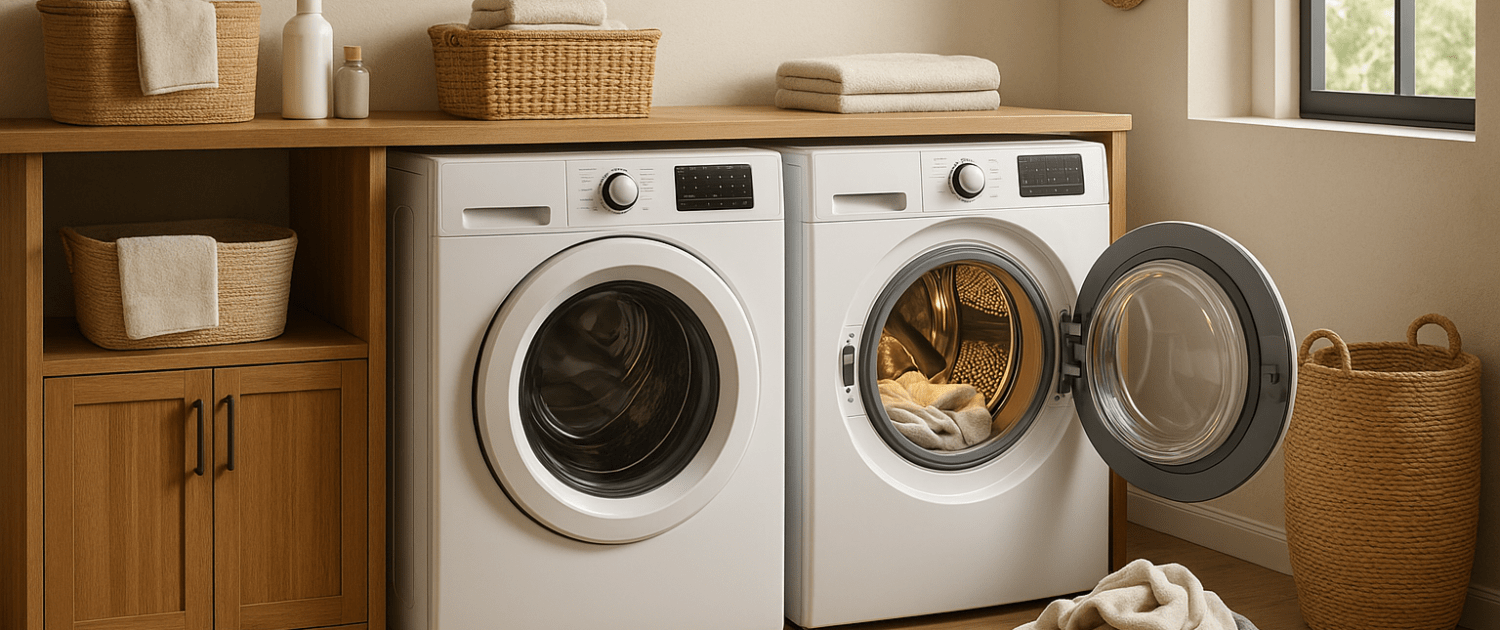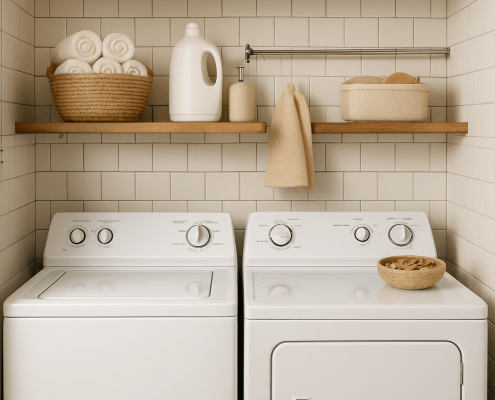Fix Your LG Washer’s Loud Vibration Problem
Steven E / Friday September 19, 2025
Looking for the right part? Enter your appliance model number below to find the exact match and get your appliance running like new again!
If your LG front-load washer is vibrating excessively, banging loudly, or not draining properly, a worn-out shock absorber may be the problem. The good news? Replacing a shock absorber is much easier than most people think. With just a couple of screwdrivers, some patience, and our video, you can test, remove, and replace the shock absorbers yourself.
Why Shock Absorbers Matter in Your Washer
Shock absorbers dampen the drum’s movement during wash and spin cycles. Without them, the drum would slam into the washer’s frame, causing loud noises, excess vibration, and long-term damage.
Signs of a failing shock absorber include:
- Loud banging noises during spin cycles
- Excessive vibration or shaking, especially when washing heavy loads
- Unbalanced loads that don’t correct themselves
- Leaks or drainage issues caused by uneven drum movement
Replacing these parts restores balance to your washer and protects other components from unnecessary wear.
Why Shock Absorbers Fail
Like any part under constant stress, shock absorbers wear out over time. Here are the most common reasons:
- Heavy loads: Overloading the washer puts extra strain on the suspension.
- Normal wear and tear: Rubber bushings naturally degrade with age and use.
- Moisture and detergent exposure: Over time, these can weaken materials.
- Imbalance: Running the washer with consistently unbalanced loads accelerates failure.
Tools You’ll Need
Before starting the repair, gather your tools:
- Phillips screwdriver
- Flathead screwdriver
Safety Reminder
Always unplug your washer or switch off the breaker before working on it. Never attempt to repair an appliance while it’s still connected to power.
Step 1: Disassembling the Washer
The first step is to access the shock absorbers by removing several panels.
- Remove the top panel. Use your Phillips screwdriver to remove the two screws at the back corners.
- Slide the panel back, lift it up, and set it aside.
- Drain excess water (if present). Open the drain filter access panel.
- Use the small drain tube to empty remaining water into a shallow container.
- Remove the dispenser drawer. Pull it all the way out, then press down on the locking tab to release.
- Set it aside.
- Remove console screws. Take out the Phillips screws located behind the dispenser drawer.
- Remove the single screw at the top right corner of the back of the display panel.
- Disconnect the console. Carefully unplug the user interface harness wires.
- Rotate the console forward, lift it, and set it aside.
- Remove the door lock. Open the washer door. Take out the two screws securing the door lock to the front panel.
- Release the door gasket. Use your flathead screwdriver to pry off the spring securing the gasket.
- Fold the gasket back inside the drum.
- Remove the drain pump cover. Open the cover and remove the Phillips screws.
- Move the cover aside.
- Disconnect the drain tube from its mounting bracket and push it into the panel.
- Remove the front panel. Take out the Phillips screw located just behind the drain cover.
- Remove the screws from the top of the panel.
- Rotate the panel forward, lift it, and set it aside.
- Remove the back access panel. Unscrew and lift away the rear panel to expose the shock absorbers.
Step 2: Checking for Shock Absorber Damage
Now that you have access, inspect each shock absorber.
- Look at the bushings: These rubber ends commonly wear down, leading to poor compression.
- Test compression: Push each absorber by hand. If one compresses much more easily than the others, it has failed.
- Check for separation: If the shaft has pulled away from the piston chamber, the absorber must be replaced.
If one absorber has failed, it’s strongly recommended to replace all of them. This keeps the washer balanced and prevents uneven wear.
Step 3: Removing the Old Shock Absorber
Once you’ve identified the faulty absorber, it’s time to remove it.
- Use your flathead screwdriver to press into the locking tabs of the hinge pin.
- Pull the pin out of the tub connection.
- Repeat the process for the pin at the base where the absorber connects to the frame.
- Pull the absorber out completely.
Repeat the process for each absorber if you’re replacing them all.
Step 4: Installing the New Shock Absorber
- Position the new shock absorber at the base of the tub.
- Insert the pin through the mounting holes and lock it into place.
- Repeat the process at the frame connection with the second pin.
- Ensure both ends are secure and properly seated.
Repeat the installation process for all shock absorbers being replaced.
Step 5: Reassembling the Washer
With the new shock absorbers installed, it’s time to put everything back together.
- Reinstall the rear panel and secure it with screws.
- Reattach the front panel. Position it on the bottom brackets.
- Feed the drain hose through.
- Secure it with the screws you removed earlier.
- Reinstall the door lock with its Phillips screws.
- Refit the door gasket and spring into position.
- Reinstall the drain pump cover and secure it.
- Reinstall the console. Reconnect the user interface harness.
- Rotate the console back into place.
- Secure it with screws.
- Slide the dispenser drawer back in.
- Reinstall the top panel by sliding it forward and securing it with screws at the back.
Step 6: Testing the Repair
- Plug the washer back into power.
- Run a short cycle with no clothes inside.
- Watch and listen for smooth operation without loud banging.
- Balanced spinning without excessive vibration.
- Proper draining at the end of the cycle.
If everything looks and sounds good, your washer is fixed.
Tips for a Smooth DIY Repair
- Replace all absorbers at once: Even if only one is bad, the others may not be far behind.
- Keep screws organized: Small cups or trays make it easy to track hardware.
- Take pictures as you disassemble, so reassembly is simple.
- Inspect other parts: While panels are open, check hoses and belts for wear.
Preventing Future Problems
To extend the life of your new shock absorbers, try these habits:
- Don’t overload the washer—stick to manufacturer guidelines.
- Distribute laundry evenly to avoid unbalanced spins.
- Run maintenance cycles to keep the drum clean and reduce strain.
Where To Find Us
Tackling this repair yourself not only saves money but also gives you the satisfaction of knowing you extended the life of your appliance.
And when you need replacement shock absorbers or any other washer parts, trust us to have the right parts in stock and ready to ship fast.
If you need any replacement parts for your appliances, you can enter your model number at AppliancePartsPros.com to locate and order them quickly. Most orders arrive in just two business days, and we have tons of great information in our repair help section and YouTube videos to help you troubleshoot.
Stay connected with the latest DIY tips, tutorial videos, and repair guides by following us on Facebook, Instagram, and Twitter. We love hearing about your repair stories and successes. If you need more help or want personalized guidance, feel free to contact or call us at 877-477-7278. We’re ready to help you take on your next project with confidence!
Since 1999, AppliancePartsPros.com has helped millions of people repair their broken appliances by providing high-quality original parts at well below retail prices, free support and troubleshooting, and award-winning customer service from an expert, friendly, US-based customer support team!
With nearly a decade of experience in providing top-notch customer service regarding appliance parts and repair, Steven enjoys sharing practical advice, troubleshooting tips, and interesting information to help readers stay informed.






Leave a Reply
Want to join the discussion?Feel free to contribute!